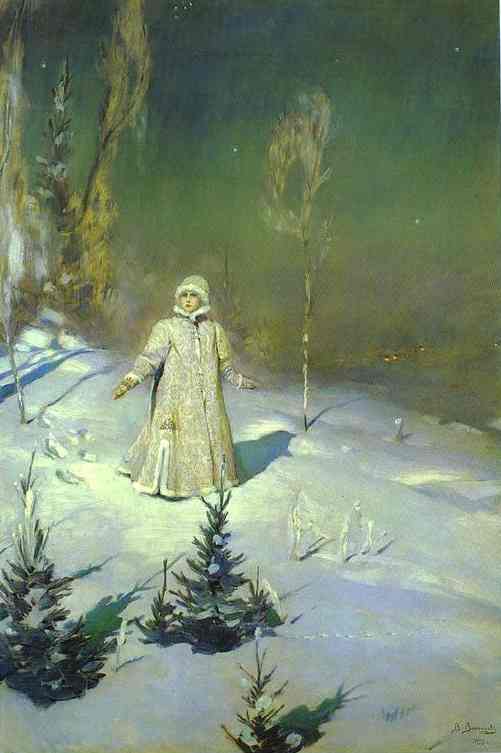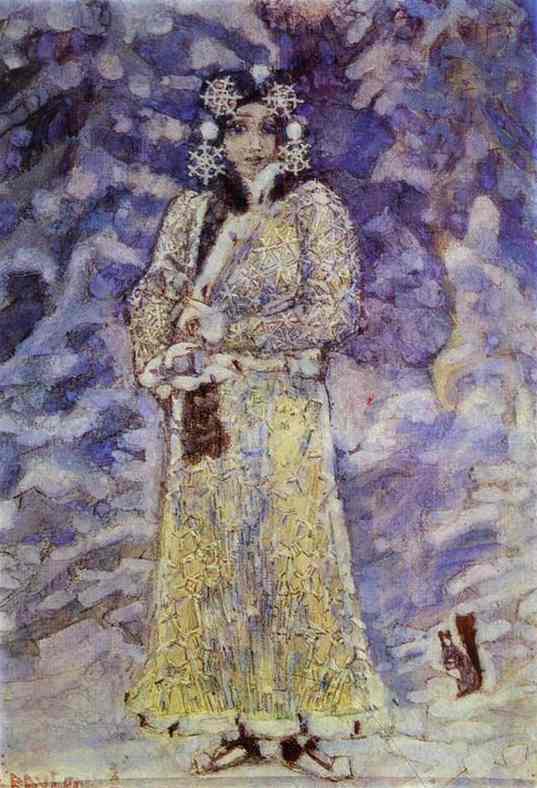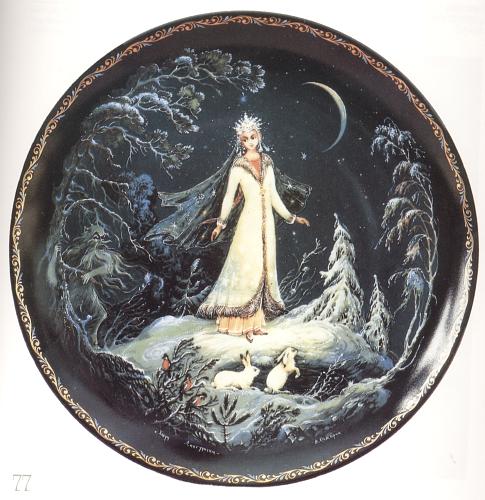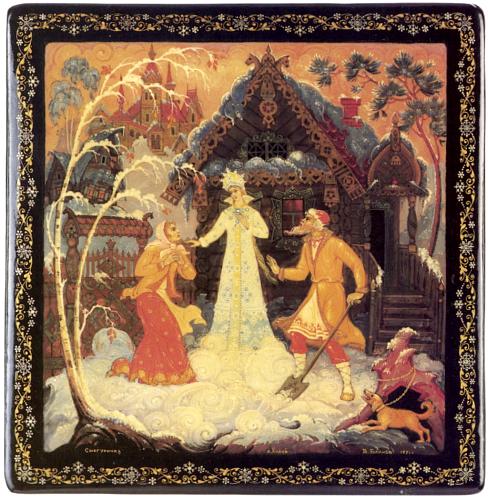 One of the most celebrated fairy tales in the Russian culture is, "The Snowmaiden." The tale is of the eternal struggle with love, losing love, and making the most out of the time given to a being on earth. Its ability to cross cultures has captivated an international audience as it was written into an opera by Piotr Tchaikovsky then Rimsky Korsakov.
Alexander Ostrovsky wrote the play based on music written by Piotr Tchaikovsky, which was performed for the first time at Moscow's Bolshoi Theater on May, 23 1873. However, a few years later Rimsky Korsakov wrote his own version of the opera, which played at the Mariinsky Theater in St. Petersburg opening on February 10, 1881. It is highly speculative which piece is better, but both composers regarded, "The Snowmaiden," as their favorite works. Not only is the opera singled out by the composers as one of their favorites, it is also unique to Ostrovsky's works as a playwright. One of the most celebrated fairy tales in the Russian culture is, "The Snowmaiden." The tale is of the eternal struggle with love, losing love, and making the most out of the time given to a being on earth. Its ability to cross cultures has captivated an international audience as it was written into an opera by Piotr Tchaikovsky then Rimsky Korsakov.
Alexander Ostrovsky wrote the play based on music written by Piotr Tchaikovsky, which was performed for the first time at Moscow's Bolshoi Theater on May, 23 1873. However, a few years later Rimsky Korsakov wrote his own version of the opera, which played at the Mariinsky Theater in St. Petersburg opening on February 10, 1881. It is highly speculative which piece is better, but both composers regarded, "The Snowmaiden," as their favorite works. Not only is the opera singled out by the composers as one of their favorites, it is also unique to Ostrovsky's works as a playwright.
 Ostrovsky's plays usually deal with high society and his best known works, "Its a Family Affair - We'll Settle it Ourselves," "The Poor Bride," and "The Dowerless Girl" fit that genre. When he was commissioned to write the play for music that was to be written by Tchaikovsky, what resulted was a human drama that develops wthin the middle class of a town called Berendeyevka. After the play and music were written one of Russia's most famous artists Victor Vasnetov, with the help of Mikhail Vrubel, painted the stage design for the theater. He made numerous costume designs and stages, the remaining of which reside in Moscow's Tretyakov Gallery.
This who's who of names from Russia's late 19th century, including two of Russia's most famous composers, two of it's most famous artists, and a highly popular playwright in Russia even today, collaborated to make "The Snowmaiden" an instant classic from the very beginning. "The Snowmaiden" was also written again to make it a lighter children's story. One of these versions made popular by "Lucy Maxym," has the Snowmaiden fall in love with Lyel, not Mizgir, then melt away. This was changed because in the first version as the Snowmaiden melts away Mizgir drowns himself, while the town of Berendey rejoices as the sun has returned warmth to the land. Another change to the morbid ending of the first version is that as she is allowed to love she jumps over a fire and turns into a mist.
As the tale gained cultural momentum the October revolution of 1917 laid the ground work for lacquer art to be born in the villages. Before lacquer art was brought to the villages the artists painted icons and needed to find good themes from which to extract paintable material. Although lacquer art existed in Fedoskino many years prior, their art revolved around painting pastoral scenes with village life as the focus, and scenes from Russian fairy tales did not start to appear until later. The Snowmaiden was perfect material to adapt into a painting, and with inspiration provived by Victor Vasnetsov's depiction of the Snowmaiden (1899), which today hangs in the Tretyakov Gallery, the main character and her story became a common theme for depicting on lacquer miniatures.
The success of images of the Snowmaiden, and scenes from the tale, in lacquer miniature, has a great deal to do with the artists who took on the subject matter. Some of the most well-known names from each of the villages took on painting this tale, and it was their idiosyncratic styles that made it en vogue for others to follow in their wake. Ostrovsky's plays usually deal with high society and his best known works, "Its a Family Affair - We'll Settle it Ourselves," "The Poor Bride," and "The Dowerless Girl" fit that genre. When he was commissioned to write the play for music that was to be written by Tchaikovsky, what resulted was a human drama that develops wthin the middle class of a town called Berendeyevka. After the play and music were written one of Russia's most famous artists Victor Vasnetov, with the help of Mikhail Vrubel, painted the stage design for the theater. He made numerous costume designs and stages, the remaining of which reside in Moscow's Tretyakov Gallery.
This who's who of names from Russia's late 19th century, including two of Russia's most famous composers, two of it's most famous artists, and a highly popular playwright in Russia even today, collaborated to make "The Snowmaiden" an instant classic from the very beginning. "The Snowmaiden" was also written again to make it a lighter children's story. One of these versions made popular by "Lucy Maxym," has the Snowmaiden fall in love with Lyel, not Mizgir, then melt away. This was changed because in the first version as the Snowmaiden melts away Mizgir drowns himself, while the town of Berendey rejoices as the sun has returned warmth to the land. Another change to the morbid ending of the first version is that as she is allowed to love she jumps over a fire and turns into a mist.
As the tale gained cultural momentum the October revolution of 1917 laid the ground work for lacquer art to be born in the villages. Before lacquer art was brought to the villages the artists painted icons and needed to find good themes from which to extract paintable material. Although lacquer art existed in Fedoskino many years prior, their art revolved around painting pastoral scenes with village life as the focus, and scenes from Russian fairy tales did not start to appear until later. The Snowmaiden was perfect material to adapt into a painting, and with inspiration provived by Victor Vasnetsov's depiction of the Snowmaiden (1899), which today hangs in the Tretyakov Gallery, the main character and her story became a common theme for depicting on lacquer miniatures.
The success of images of the Snowmaiden, and scenes from the tale, in lacquer miniature, has a great deal to do with the artists who took on the subject matter. Some of the most well-known names from each of the villages took on painting this tale, and it was their idiosyncratic styles that made it en vogue for others to follow in their wake.
 In Kholuy Nikolay Baburin's "Snowmaiden" (1973) is considered his best work that pin-pointed the peak he reached artistically. There is another more recognizable depiction of the Snowmaiden, originally painted in 1988 by Anatoliy Kamorin, in a simple forest setting wearing a light blue dress against a starry black background. This is one of the more common pieces the Kholuy factory produces on a yearly basis and can be considered on the village's signature works.
It was Fedoskino's realistic oil painting style that led some artists to adapt Victor Vasnetsov's original. They did it in an indirect way, in that they made the landscape clearer and the Snowmaiden brighter. Often in depictions of the Snowmaiden there are inlays of mother of pearl to heighten the effect of the connotation of the freezing power of winter. Fedoskino artist looking to put their own unique spin on the tale took part in making scenes with her in very original fashion. Another well known depiction of the Snowmaiden from Fedoskino is Gennady Larishev's interpretation (1977) of the girl as she is met by the town. She stands off center with the elderly couple that will take care of her, with the townspeople watching nearby and the town in the background. In Kholuy Nikolay Baburin's "Snowmaiden" (1973) is considered his best work that pin-pointed the peak he reached artistically. There is another more recognizable depiction of the Snowmaiden, originally painted in 1988 by Anatoliy Kamorin, in a simple forest setting wearing a light blue dress against a starry black background. This is one of the more common pieces the Kholuy factory produces on a yearly basis and can be considered on the village's signature works.
It was Fedoskino's realistic oil painting style that led some artists to adapt Victor Vasnetsov's original. They did it in an indirect way, in that they made the landscape clearer and the Snowmaiden brighter. Often in depictions of the Snowmaiden there are inlays of mother of pearl to heighten the effect of the connotation of the freezing power of winter. Fedoskino artist looking to put their own unique spin on the tale took part in making scenes with her in very original fashion. Another well known depiction of the Snowmaiden from Fedoskino is Gennady Larishev's interpretation (1977) of the girl as she is met by the town. She stands off center with the elderly couple that will take care of her, with the townspeople watching nearby and the town in the background.
 Mstera and Palekh played a roll in the development in the legend as a whole and did not focus strictly on the Snowmaiden herself. Their compositions were based on points of interest in the tale and specific scenes. One of the more popular is when the Snowmaiden meets Tsar Berendey. There are also interpretations on the final outcome, if she melts or disappears into a mist. Sometimes a composition can depict the entire story, which Mstera's Anatoliy Shirokov has done quiet well.
The fantasy based plot of the tale is one that combines old pagan beliefs with problems in everyday contemporary life. The presence of the Sun-god, Father Frost (ruler of winter), Fairy Spring (ruler of spring), and the Wood Spirit show that this story has its roots in the classic mythology associated with pre-Christian schools of thought that were prevalent in Russia in medieval times. One thing that has not change, or has been swept out of human nature, is the question of why we love, why we don't sometimes, and what fuels desire.
Not only is "The Snowmaiden" a Russian tale, it is escapes the stigma of cultural boundaries, because the theme is such a universal one. Made famous in the late 19th century it has lived on in music, paintings, and has a firm hold in today's contemporary lacquer art industry. Mstera and Palekh played a roll in the development in the legend as a whole and did not focus strictly on the Snowmaiden herself. Their compositions were based on points of interest in the tale and specific scenes. One of the more popular is when the Snowmaiden meets Tsar Berendey. There are also interpretations on the final outcome, if she melts or disappears into a mist. Sometimes a composition can depict the entire story, which Mstera's Anatoliy Shirokov has done quiet well.
The fantasy based plot of the tale is one that combines old pagan beliefs with problems in everyday contemporary life. The presence of the Sun-god, Father Frost (ruler of winter), Fairy Spring (ruler of spring), and the Wood Spirit show that this story has its roots in the classic mythology associated with pre-Christian schools of thought that were prevalent in Russia in medieval times. One thing that has not change, or has been swept out of human nature, is the question of why we love, why we don't sometimes, and what fuels desire.
Not only is "The Snowmaiden" a Russian tale, it is escapes the stigma of cultural boundaries, because the theme is such a universal one. Made famous in the late 19th century it has lived on in music, paintings, and has a firm hold in today's contemporary lacquer art industry.
|



